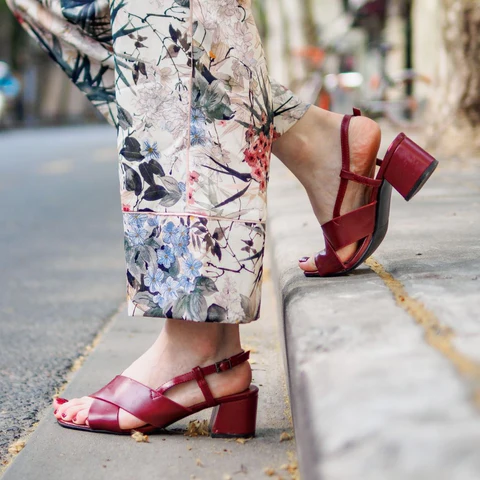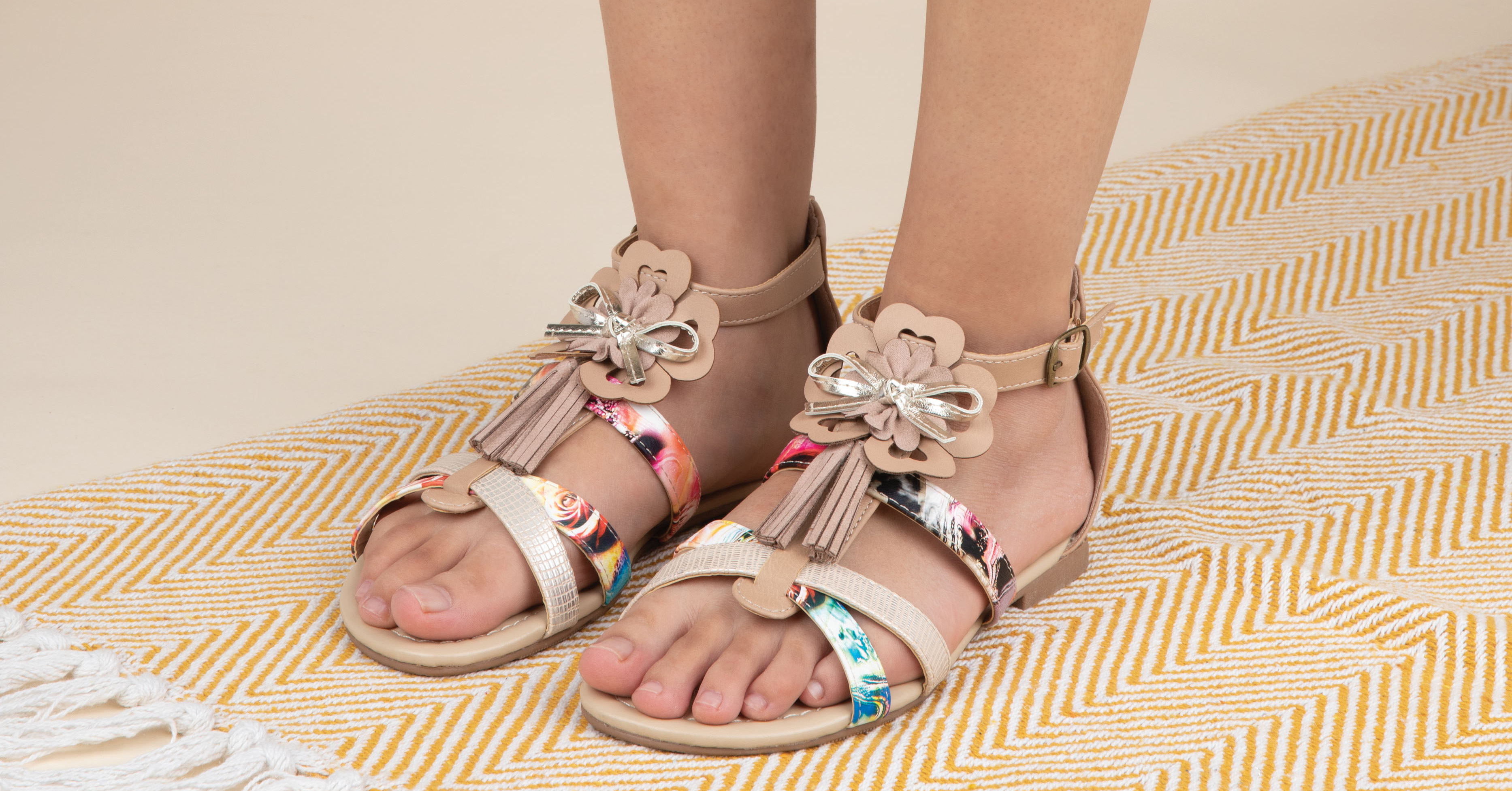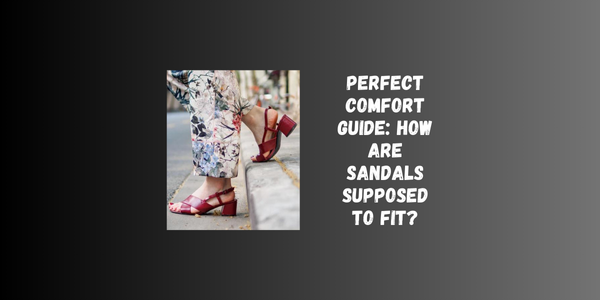Sandals should fit snugly but comfortably, allowing for a bit of wiggle room for your toes. Straps must hold your foot securely without pinching or causing discomfort.
Finding the right fit for sandals is essential for comfort and foot health. A proper fit ensures you can walk confidently without blisters or discomfort.
Sandals come in various styles, each with unique fitting guidelines. Different materials and designs affect how they should fit.
Consider factors like arch support and foot width when choosing. Always try sandals on with the type of socks you plan to wear, if any.
Pay attention to how the straps align with your foot. Taking time to find the right fit can enhance your summer outings and keep your feet happy.
The Importance Of Proper Sandal Fit
Wearing sandals that fit correctly is vital for comfort and health. Proper fit can enhance your walking experience. Sandals that are too tight or too loose can cause pain. This section explores the balance between comfort and style.

Credit: paco.ie
Comfort Vs. Style
Finding sandals that look good and feel great can be tricky.
- Comfort: Proper cushioning is essential. Look for sandals with arch support.
- Style: Many sandals come in trendy designs. Choose styles that match your wardrobe.
Consider the following points:
- Try sandals on at the end of the day.
- Walk around to test comfort.
- Check for any pinching or slipping.
Always prioritize comfort. Style can follow, but it shouldn’t cause pain.
Potential Foot Problems From Ill-fitting Sandals
Wearing the wrong sandals can lead to various foot issues. Common problems include:
| Foot Problem | Description |
|---|---|
| Blisters | Friction from loose sandals can cause painful blisters. |
| Flat Feet | Improper arch support may lead to flat feet. |
| Calluses | Pressure points from tight sandals can create calluses. |
| Ingrown Toenails | Too-tight sandals can push nails into the skin. |
Choose sandals wisely to avoid these problems. Proper fit prevents discomfort and supports foot health.
Key Considerations For Sandal Sizing
Choosing the right size for sandals is essential. Proper fit affects comfort and foot health. Here are some key factors to consider.
Foot Length And Width
Measuring your foot is the first step. Use these tips for accurate measurements:
- Stand on a piece of paper.
- Trace your foot outline carefully.
- Measure from the heel to the longest toe.
- Measure the widest part of your foot.
Compare your measurements to the brand’s size chart. Remember that different brands may have different sizes. Here’s a simple table to help:
| Size (US) | Foot Length (inches) | Foot Width (inches) |
|---|---|---|
| 6 | 9.25 | 3.5 |
| 7 | 9.5 | 3.625 |
| 8 | 9.75 | 3.75 |
| 9 | 10 | 3.875 |
Ensure there’s enough room. The sandal should not pinch or squeeze your foot. A good fit allows for about a thumb’s width of space at the front.
Arch Support Needs
Arch support is vital for comfort. Different sandals offer varying levels of arch support:
- Flat sandals provide little to no support.
- Contoured sandals support the arch well.
- Adjustable straps help customize the fit.
Identify your arch type:
- Low Arch: Look for sandals with extra cushioning.
- Normal Arch: Most sandals will work for you.
- High Arch: Choose sandals with good arch support.
Try on sandals at the end of the day. Your feet expand during the day. Ensure they feel comfortable and supportive.
Types Of Sandals And Their Fit
Finding the right fit for sandals is essential. Different styles offer unique fits. Understanding these types helps ensure comfort and support.
Flip-flops
Flip-flops are casual and easy to wear. They have a simple design with a toe post. Here are key fit points:
- Should fit snugly but not too tight.
- Heel should not hang off the back.
- Foot should stay comfortably inside the sole.
Flip-flops are best for short outings. They lack arch support, so choose wisely.
Slides
Slides are a popular choice for ease. They have an open toe and back. Consider these fit tips:
- Straps should be secure but not restrictive.
- Foot should be centered on the footbed.
- Extra space may lead to slipping.
Slides work well for casual wear. They offer quick on-and-off convenience.
Strappy Sandals
Strappy sandals are stylish and versatile. They come with multiple straps across the foot. Important fit aspects include:
- Straps should hold the foot securely.
- Adjustable features help achieve the right fit.
- Check for comfort around the ankle.
These sandals can be dressed up or down. Ensure they fit well to avoid blisters.
Sport Sandals
Sport sandals are designed for outdoor activities. They provide stability and support. Key fit considerations are:
- Straps should be adjustable for a custom fit.
- Footbed should contour to your foot shape.
- Test for comfort during movement.
Sport sandals are great for hiking or walking. Choose a pair that offers good grip.
Measuring Your Feet For The Perfect Fit
Finding the right sandals starts with measuring your feet. Proper fit ensures comfort and support. Follow these steps to measure your feet accurately.
Tools You’ll Need
- A ruler or measuring tape
- A piece of paper
- A pencil
- A flat surface
Step-by-step Guide
- Place the piece of paper on a flat surface.
- Stand barefoot on the paper, keeping your heels against a wall.
- Trace your foot outline using the pencil.
- Measure the longest distance from the heel to the toe.
- Repeat for the other foot, as sizes may differ.
- Compare measurements to size charts from brands.
Use the largest measurement for your size selection. Feet swell during the day. Measure in the evening for the best fit. Sandals should feel snug but not tight.
| Foot Length (inches) | US Size |
|---|---|
| 8.5 | 5 |
| 9.0 | 6 |
| 9.5 | 7 |
| 10.0 | 8 |
| 10.5 | 9 |
Always try on sandals before buying. Walk around to ensure comfort. A perfect fit allows for movement without slipping.
Adjusting For The Perfect Fit
Finding the right fit for sandals is crucial. A perfect fit enhances comfort and style. Small adjustments can make a big difference in how they feel. Here are some ways to ensure your sandals fit just right.
Using Insoles
Insoles can provide extra support and comfort. They fill gaps and reduce friction. Follow these tips for using insoles:
- Choose insoles that match your foot type.
- Look for cushioned insoles for extra comfort.
- Check if the insole fits snugly inside the sandal.
Strap Adjustments
Adjusting the straps is key for a secure fit. Straps should hold your foot without pinching. Here’s how to adjust them:
- Loosen the straps if your foot feels cramped.
- Tighten the straps if your foot slides around.
- Test the fit while standing and walking.
Straps should lay flat against your skin. They should not dig into your foot.
When To Consider A Professional Fitting
Sometimes, a professional fitting is necessary. Consider this option in these cases:
| Situation | Action |
|---|---|
| Pain or discomfort | Seek a fitting expert. |
| Special foot conditions | Consult a podiatrist. |
| Unusual foot shape | Get custom sandals or advice. |
Professional fitters can identify issues you may not notice. They provide tailored solutions for your sandals.

Credit: www.reddit.com
Seasonal Considerations In Sandal Fit
Understanding how weather affects sandal fit is crucial. Temperature changes can impact your feet. Here’s how to adjust your sandals for different seasons.
Summer Swell
Hot weather causes feet to swell. This can make sandals feel tight. Here are some tips for summer fit:
- Choose adjustable straps for comfort.
- Look for breathable materials to keep feet cool.
- Consider sizing up if your feet feel cramped.
Wearing sandals in the summer should feel easy. If sandals are too tight, blisters may form. Always check for enough room in the toe area.
Cold-weather Contraction
Cold weather can make feet shrink. This might lead to loose sandals. Here’s how to address this issue:
- Wear thicker socks with sandals.
- Opt for closed-toe sandals for added warmth.
- Make sure straps are snug but not too tight.
Sandals should feel secure in colder months. Adjusting for shrinkage helps keep your feet safe. Avoid slipping by ensuring a proper fit.
| Season | Fit Considerations |
|---|---|
| Summer | Adjustable straps, breathable materials, consider sizing up |
| Winter | Thicker socks, closed-toe options, snug straps |
Maintaining Your Sandals For Lasting Comfort
Keeping your sandals in great shape is crucial for comfort. Proper maintenance extends their life and ensures a perfect fit. Follow these tips to enjoy your sandals longer.
Cleaning Tips
Regular cleaning keeps your sandals fresh. Here are some easy steps:
- Remove dirt: Use a soft brush to remove loose dirt.
- Wash straps: Mix mild soap with warm water. Use a cloth to wipe the straps.
- Clean soles: Scrub the soles with a brush. Rinse well to remove soap.
- Dry properly: Let sandals air dry. Avoid direct sunlight.
Storage Solutions
Proper storage prevents damage and keeps sandals comfortable. Follow these tips:
- Keep them dry: Store sandals in a dry area.
- Avoid stacking: Place them upright or in separate boxes.
- Use dust bags: Protect from dust with soft bags.
- Check for pests: Ensure no insects damage your sandals.
With these simple steps, your sandals will remain comfortable and last longer.

Credit: www.shoezone.com
Troubleshooting Common Fit Issues
Finding the right fit for sandals is essential. Common issues can disrupt comfort. Here, we address these problems and provide solutions.
Too Tight Or Too Loose
Sandals should fit snugly but not too tight. A good fit allows for slight movement. Here are signs of poor fit:
- Too Tight: Red marks or indentations on the skin.
- Too Loose: Feet slide or move around excessively.
To fix these issues:
- Try a different size or width.
- Use adjustable straps if available.
- Consider insoles for added support.
Blisters And Chafing
Blisters can form from friction. Chafing occurs from rubbing against the skin. Follow these tips to prevent these problems:
- Choose sandals with soft linings.
- Break in new sandals gradually.
- Wear moisture-wicking socks if necessary.
For existing blisters:
- Clean the area gently.
- Cover with a blister bandage.
- Avoid popping blisters.
Sandal Slippage
Sandal slippage can lead to instability. This often occurs with loose straps. To fix slippage:
- Adjust straps to fit snugly.
- Choose sandals with a textured footbed.
- Opt for styles with ankle support.
A well-fitted sandal enhances comfort. It also prevents injuries. Always assess fit before purchasing.

Credit: www.earthrunners.com
Frequently Asked Questions
- How Tight Should Sandals Fit?
Sandals should fit snugly without pinching or causing discomfort. Aim for a secure feel without excessive pressure.
- Should My Toes Touch The Front?
Toes should not touch the front of the sandal. Leave a small gap for comfort and proper circulation.
- What If Sandals Are Too Loose?
Loose sandals can cause blisters and instability. Consider using insoles or adjusting straps for a better fit.
- How To Check Sandal Width?
Check width by ensuring your foot doesn’t spill over the sides. There should be slight space without excessive tightness.
- Are Adjustable Straps Necessary?
Adjustable straps are essential for a personalized fit. They allow you to customize comfort and support for your foot. “`
Conclusion
Finding the perfect fit for sandals is essential for comfort and style. Proper fitting ensures support and prevents blisters. Remember to measure your feet regularly, as size can change over time.
A well-fitting sandal can enhance your overall look and keep you comfortable all day long.
Enjoy your summer with the right pair!

